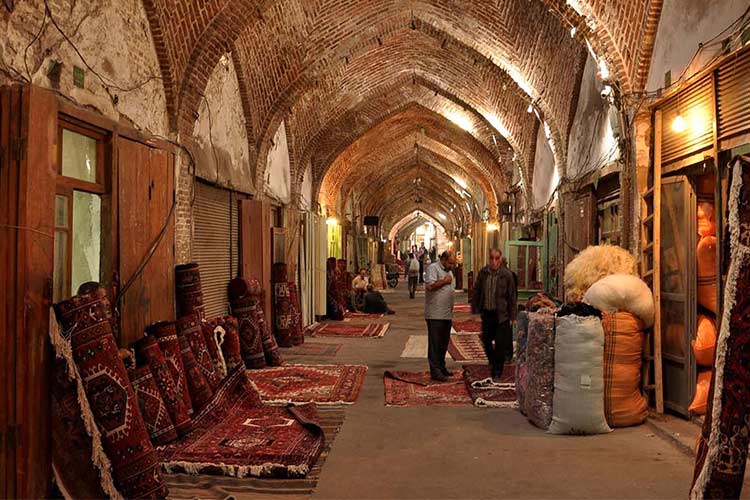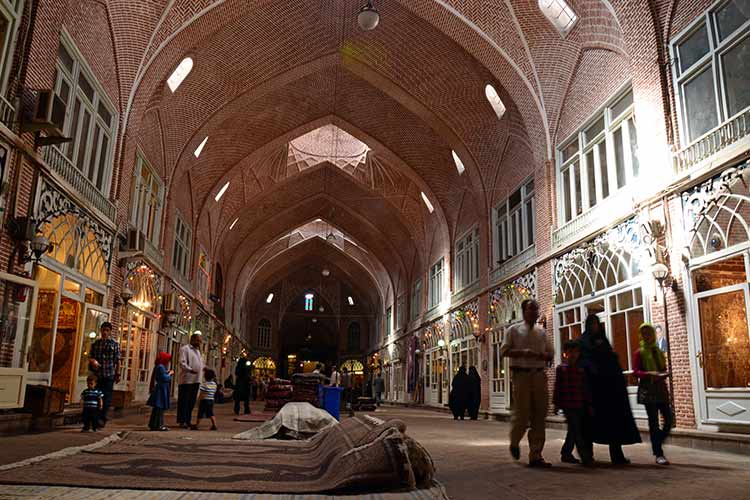
Tabriz Historic Bazaar Complex
Tabriz Historic Bazaar Complex (Tabriz Grand Bazaar)
The bazaar is one of the main places of cultural interaction since antiquity and plays a more important role than commerce. Bazaar, in its original concept of Iranian culture, included commercial, religious, cultural, health and educational subsets, which formed the heart of the city. The historical complex of Tabriz Bazaar is one of the most important shopping centers of the Silk Road. The Tabriz Historic Complex is the largest and most interconnected of the world's covered brick buildings, with an area of approximately one square kilometer. It was a central commercial heart of much of Asia and the Middle East. This incredible complex consists of shopping centers and corridors called the manufacturer or the name of the founder. The process of forming the Tabriz Bazaar began from the 3rd century around the central mosque and the government collection.

In the thirteenth century, Tabriz was the capital of the Safavid dynasty, when the grand bazaar of Tabriz passed the most brilliant period. Transferring the capital city from Tabriz and changing the political regime of the city had no impact on the trade and social regime of Tabriz. Today, one of the most comprehensive examples of the traditional Iranian trading and cultural system is found in the Tabriz Grand Bazaar.
The city of Tabriz has been exposed to large earthquakes and has been rebuilt after any destruction. The ruler of Tabriz Najmahghali khan rebuilt the Tabriz bazaar after the great earthquake of 1193 AD. The Tabriz Bazaar based on its architectural features and its continuing role in history was inscribed on the Iranian National Heritage in 1974 and on the UNESCO World Heritage List in 2010.
Many tourists and researchers such as Moghadasi, Yaguti, Marco Polo, Ibn Battuta, Hamdallah Mustawfi, Kalanchoe, John Cartwright and Jean Chardin throughout history traveled to Tabriz and mentioned it in their travel diaries and reports. The first map of the Tabriz Grand Bazaar was drawn in part of the map of Dar al-Saltaneh by Asad-allah Khan Maragheie. Because of this map, the center of Tabriz is located in quadrilateral and the bazaar in the center of it.
Look at the Iran Tours to explore the attractions or send us a Message
The names of the important parts of the bazaar are mentioned on this map. Most of Tabriz Bazaar's markets have three floors, the basement serves as a store, the second floor of the store and the workplace and the third level is designed for rest and comfort.

The cultural role of Tabriz Bazaar in the Muharram era and the large gathering of marketers and mourners are the most important cultural profile of this cultural and commercial complex. The sustainable role of the Tabriz market is reflected in the design of its fabrics and in its diversified architecture.
Trade:
From the second half of the 13th century, English traders went to the Tabriz market by the Silk Road and after crossing the cities of Istanbul and Trabzon. This market was transformed into a British business center under the reign of Abbas Mirza.
After the 13th century, Tabriz was the main center of European trade with northern Iran. Tabriz was superior to the cities of Iran and covered 25 to 33% of the total trade relations of the country in 1877. In addition, in 1906, Tabriz was the main center of Iranian trade with Central Asia.

Mirrors, types of silk fabrics, velvet and cotton, calico, chitin, glass, metal, sugar and other machinery products are now being traded in the bazaar. Tabriz merchants also sell silk and some silk machines, rifles, tobacco, nuts, dyes, shawls and waxes to European markets. Of course, this has always been the case and it would be in the interest of Europeans.
In the past, one of the main pillars of the Tabriz market was the Armenians. With regard to the statistics of the French consulate, the number of Armenians in Tabriz was more than 5,000 in 1906.
The historical bazaars in Iran now are not only a place for shopping. If you are in Tabriz and you don’t want to buy anything, the Tabriz Bazaar is a must see attraction that you should visit.
Look at the Iran Tours to explore the attractions or send us a Message

Share your feedback, experience, and questions with us
You are seen here!
By submitting your feedback, criticisms, and suggestions, you contribute to others' choices